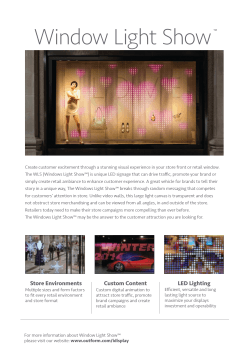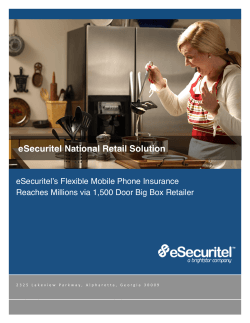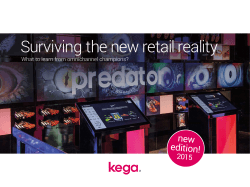
READ NOW - Retail Analytics Council
From Platt Retail Institute’s Resource Library See the entire PRI Resource Library at www.plattretailinstitute.org/library Bringing Research to Retail SM What Mobile Means to Retailing: It’s Not About Better Targeting By Frank Mulhern, Ph.D., Associate Dean/Department Chair, Integrated Marketing Communications Department, Medill, Northwestern University, and Director, Retail Analytics Council About PRI Platt Retail Institute (PRI) is an international consulting and research firm that focuses on the use of technology to impact the customer experience. In an omni-channel environment, PRI works with its clients to develop marketing strategies that build brands by integrating various customer-facing technologies. This document is not to be reproduced or published, in any form or by any m e a n s without the express written permission of Platt Retail Institute. This material is protected by copyright pursuant to Title 17 of the U.S. Code. www.plattretailinstitute.org M uch is discussed these days about how mobile technologies are transforming marketing communications. The conversations primarily address: 1) how mobile devices allow hyper-charged direct marketing – sending messages to individuals through always-on devices; and, 2) location-based messaging that increases the timeliness of communications based on the knowledge of where the consumer is located at any point in time. From the point of view of the marketer, these are undeniable improvements. Traditional direct communications are fraught with inefficiencies that mobile technologies reduce, and, given the near-zero marginal cost of sending a message to an online device, mobile seems poised to foster an era of more effective direct marketing. Such an approach to mobile marketing is typical of how new communications technologies are incorporated into a media ecosystem. Essentially, when a new platform emerges, content from existing platforms is migrated onto it. Hence the first television ads were radio ads with a video of the broadcaster; the first Internet ads were magazine ads on a computer monitor; and the first mobile ads are web ads modified for small screens. Marketers are now furiously seeking ways to better target ads to consumers based on location – a phenomenon not missed by retailers who are installing Wi-Fi and beacons in stores, often with the purpose of sending targeted ads or promotions to shoppers based not just on their presence in the store, but also on where in the store the customers presently are located. All of this has the potential to make marketing communications more efficient and effective. After all, why would shoppers not want messages and offers that are relevant and engaging more than ones that are less precisely targeted? The point being missed by this approach to mobile is, as pointed out in The Cluetrain Manifesto: The End of Business as Usual in 2001, “There is no demand for messages.” If consumers don’t want messages, what do they want? Writing in the 1960s, Marshall McLuhan achieved fame describing media technologies as “extensions of the self.” Future anthropologists will certainly evaluate how people in the current era relentlessly carried and used so-called smartphones to interact with the world. Today’s smartphones, like all media technologies, are temporary. Smaller, smarter, and less visible devices will surpass Copyright © PLATT RETAIL INSTITUTE LLC 2015 All rights reserved. What Mobile Means to Retailing (cont’d.) them – the next evolution of which is perhaps the new Apple Watch. Technology is increasingly blending with the human body (think pacemakers, artificial joints, hearing aids). So too, media technology will blend with humans to provide seamless connectivity now clumsily provided by what will soon be regarded as massively oversized pocket computers. In the recent book, The Mobile Mind Shift, the authors describe how mobile devices have become the go-to tool where a person “can get what I want in my immediate context and moments of need.” What consumers don’t want are interruptive messages, pop-up ads and videos, or, more broadly, messages that come from marketers. What they do want is access to information and services from others, including marketers, peers, social networks, etc. Returning to the question posed in the title, mobile should not be viewed as the ultimate location-based direct marketing device. Rather, it should be viewed as the ultimate customer service tool. Upon entering a store, a shopper has numerous questions in mind. Does this store carry a certain item? Where in the store is that item located? How much does it cost? How does that price compare to other retailers? What kinds of reviews does that item get in social media? Where can I find a sales clerk? For answers to all of those questions, the shopper looks to her mobile device. The mobile device serves as the technology through which shoppers communicate to retailers, not the other way around – and certainly not the way direct marketers do. PRI Offices U.S. Office: P.O. Box 158 Hinsdale, IL 60522 USA Phone: 312.265.6106 contact@plattretailinstitute.org German Office: Rather Kirchplatz 11 40472 Dusseldorf Germany Phone: [49] 211 59896507 frankr@plattretailinstitute.org Spanish Office: Ctra de Mig, 75 08907 L'Hospitalet de Llobregat Barcelona, Spain Phone: [34] 981847755 juanc@plattretailinstitute.org 2 The implication of this approach to mobile for retailers is simple. Retailers should use digital technologies to create extraordinary customer experiences by providing excellent customer service in stores, and more broadly, throughout the entire shopper experience. Retailer mobile services can include in-store maps, product availability, prices, detailed descriptions and reviews, store clerk availability, payment options, and a variety of other experience-enhancing services. Consumer research can reveal what shoppers want in a shopping experience and mobile devices serve as the technology for digitally enhanced experiences. The Mobile Mind Shift provides an example of how mobile enhances the customer’s journey at Starbucks where the customer uses a smartphone to: locate a store and get directions; check a Starbucks card balance and potentially reload money; check reward options or promotions; redeem an award or accept a promotion; scan to pay; and, post-purchase, send an eGift to a friend or add a tip for the barista. Except for the promotional offer, each of these is a form of customer service, not marketing messaging. Customer service remains one of the few opportunities for sustainable competitive advantage, mostly because it is not done very well. Digital technologies, primarily accessed through mobile devices, allow marketers to provide levels of service never before possible. We are seeing this currently develop in the hospitality industry where customers make reservations, check in, gain access to their room, order room service, check the posted charges, and check out. These are all elements of customer service and ways to enhance the customer experience (as well as obtain enormous amounts of customer-specific data). Retailers have the opportunity to gain competitive advantage through mobile-based customer service. What Mobile Means to Retailing (cont’d.) Connect with PRI: Frank Mulhern, Ph.D., is Associate Dean/Department Chair, Integrated Marketing Communications Department, Medill, Northwestern University, and Director, Retail Analytics Council. 3 Returning to McLuhan's media as “extensions of the self,” mobile devices are seen as the “sense” (McLuhan wrote extensively about media and the five senses) through which the shoppers interact with the store. Actually walking around a store, looking at things, touching products, and talking to sales clerks become components of an integrated digital-plus-real-world experience that engages the shopper with the retail brand and satisfies the shoppers’ wants. Retailers should no longer see mobile devices as threats because they facilitate showrooming – they should see them as remarkable tools to enhance shopper experiences.
© Copyright 2025









